Begin your journey here
Dip into decades of P&O's history from paddle steamers to passenger liners and ports. Experience 185 years of life at sea and ashore with P&O.
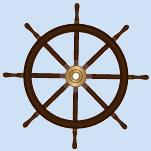
Loading Content...
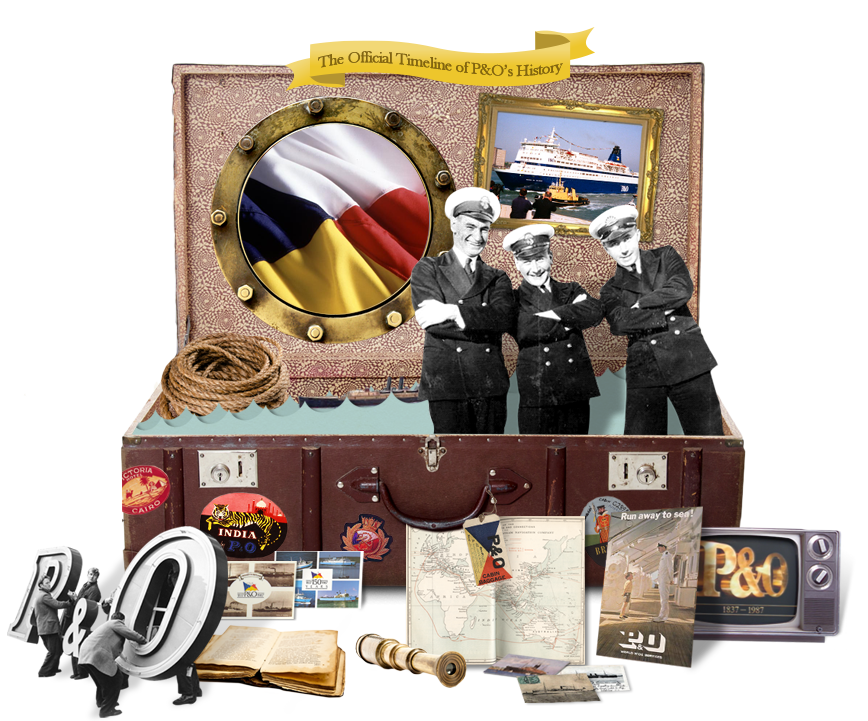


The Irish led the way and, among them, two Dublin ship owners, Charles Wye Williams and Captain Richard Bourne, who were successfully running paddle steamers in the 1820s. It was a costly business but both men realised that the future of steam lay in operating larger ships on longer voyages and subsidised ‘mail’ services.
In 1834 Bourne chartered a steamer to the London ship brokers and agents, Willcox and Anderson, who were running speculative services to Spain and Portugal. Like Bourne, Brodie McGhie Willcox and Arthur Anderson had ambitious plans to operate regular steamers to rival the Government’s existing ‘mail packet’ service to the Peninsula. But, unlike Bourne, Willcox and Anderson had neither their own steamers nor any experience of mail contracts. Joining forces was an obvious solution.
Three years later, on 22nd August 1837, Bourne secured a Government contract for the Peninsular mails to be managed by Willcox and Anderson under the aptly named ‘Peninsular Steam Navigation Company’. Traditionally regarded as the Company’s foundation date, the first mail contract marks the start of our P&O story.
Arthur Anderson’s quick thinking helped to save the mails and $21,000 in cash when Don Juan ran into fog just off Gibraltar on the homeward leg of her first voyage in September 1837. Anderson arranged help from HMS Medea to return the mails and Captain Engledue of Don Juan home to the UK and luckily no lives were lost.
P&O, as it could now rightly be called, embarked on a period of empire building in the East. Investment in larger ships, coaling stations and infrastructure enabled the Company first to cross Egypt and then to reach India in 1842 (via Aden) before continuing further East to Ceylon, Penang, Singapore and Hong Kong in 1845.
By the close of the decade the P&O fleet boasted 23 steamers with a further two under construction. Only five continued to ply the original Peninsular route. The remainder were bound for the Orient where they were engaged in mail contract or speculative services including: Southampton to Alexandria, Gibraltar to Genoa, Suez to Calcutta, Bombay to China and Hong Kong to Canton.
P&O had pursued a strategy of first obtaining mail contracts and then further marking their territory with branch or feeder services intended to ward off competitors and, in the case of the Bombay to China run, to benefit from the lucrative trade in opium.
The first P&O ship with two funnels, and fitted with bathrooms, was Great Liverpool. She was renamed ‘Great’ to avoid confusion with the earlier, smaller Liverpool.
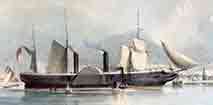
But scarcely had the joys of the new faster mail service been felt before P&O was forced to suspend the route on account of the war in Crimea. The Company’s best and latest ships were required, including Himalaya, then the largest steamship in the world. The Anglo-Persian war of 1856 created a further demand for troop transports, swiftly followed by the Indian Mutiny a year later.
Normal service was eventually resumed and the Company continued to win new mail contracts and expand its reach to the Philippines and Mauritius (on a new route to Australia). There were new ships too, now with screw propellers, which were more powerful and efficient than the paddle wheels they replaced. By the end of the decade 38 of the 55-strong fleet were screw steamers including Malabar, which endeared P&O to a thirsty nation of tea lovers, as the first Company to carry tea by steamer from China in 1859.
Florence Nightingale travelled on board Vectis from Marseilles to Constantinople in October 1853 at the start of the Crimean War.
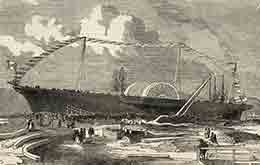
Panic peaked in 1867 when termination notices were issued on P&O’s existing mail contracts. The incoming Conservative Government signalled that ‘all the world’ would be invited to tender, including Messageries Imperiales.
Thrown into a fight for survival, the Board published a ‘Statement’ of the Company’s Position and Operations’ from 1840 to 1866, leaving the reader in little doubt of P&O’s contribution to the nation, for a quarter of a century. And as if on cue, the Company was again called upon to serve the Empire, transporting troops and supplying coal and water in the Abyssinian War of 1867.
As the last survivor of the original founders, it fell to Anderson, as Chairman, to lead the charge and keep the Company from collapse. Reprieve came in November 1867 when Parliament voted in favour of a new 12 year mail contract for all lines to India, China and Japan. Patriotism and P&O had prevailed. The Company was safe, for now...
In 1861 Mooltan was the first ship to have ice-making facilities - a luxury not even dreamed of 20 years before. Ice was a necessity in the heat and by 1866 P&O was consuming 1,360 tons a year, at a cost of £7,000.
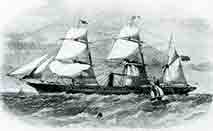
Freight rates plummeted and the Company’s fleet, built for a pre-Suez age, was suddenly ‘out of date’ - no longer fit for purpose. The mail contracts which had saved P&O at the end of the previous decade, now threatened to stifle the Company. The conservative Post Office, which had replaced the Admiralty in 1861, chose to ignore the Canal insisting that the mails were carried on the British-owned railway from Alexandria to Suez.
As competition grew and passage revenue fell, P&O was still bound by contract to carry the civil servants, soldiers and missionaries (which made up two-thirds of its passengers) at reduced rates.
The Company was in dire straits. Thomas Sutherland, first called upon by Arthur Anderson in the crisis of late 1860s, was appointed to serve alongside James Allan and Henry Bayley, in 1872, and to dig the Company out of De Lesseps famous ‘ditch’.
The amazing acrobat, Chevalier Blondin, walked a tightrope suspended between the main and mizzen masts of P&O's Poonah in 1875.
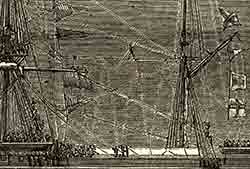
Sutherland was appointed Chairman in 1882 and presided over a fervent building programme, begun ten years earlier, which focussed on speed, efficiency and greater capacity for freight and passengers. In the course of the decade, 29 new ships were launched beginning with Ravenna, the first Company vessel to be built of steel.
The largest and grandest of the new steamers, the 6,000 ton, four-strong, Jubilee Class - Victoria, Britannia, Arcadia and Oceana - aptly marked the occasion of the Company’s, and Queen Victoria’s, Golden Jubilee in 1887.
Such investment in new tonnage was courageous, particularly at a time when trading conditions, though improving, were still challenging. In 1883 a cholera epidemic, unrest in Egypt and bureaucracy on the Canal wreaked havoc with the mail schedules and Eastern trade.
In the same year the Company was joined on the route down under by a new competitor, the Orient Steam Navigation Company, operating under a mail contract from the Australian Government. P&O and ‘Orient’ would go on to dominate the UK/Australia run for the best part of the next 80 years.
P&O's Peninsular was said to be haunted by footsteps 'that walked around the Captain and Chief Officer’s cabins' on the hurricane deck. The ship was even investigated by the Bombay Psychical Society.
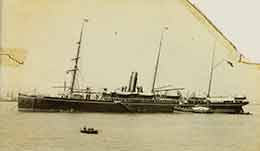
Working on the principle that a ship’s useful life was about 20 years, older ships were sold off to make way for new. The majority of the new steamers were passenger liners, designed specifically for the mails and increasing in size with every year. But there were a few exceptions such as P&O’s first real cargo ship and a pair of relatively small (2,000 tons), express steamers, Osiris and Iris. These two vessels ran between Brindisi and Port Said on a weekly express mail service, operated by P&O under contract from the Italian Government in 1898.
Being both fast and capacious, mail steamers were equally well-suited to the job of trooping. In 1894 the Government chartered Britannia and the newly-lengthened Rome to carry troops to India in the six-month ‘trooping season’. It was a mutually beneficial arrangement which continued with the Ashanti Expedition and, of necessity, extended to the use of four steamers when the Boer War began in 1899.
P&O's first onboard telephone was fitted on Parramatta in 1892. The new telephone connected the bar to the smoking room.
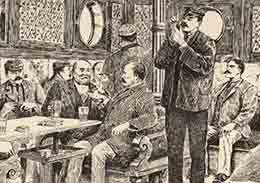
When peace returned, the Company met the demand for new tonnage with a new class of powerful steamer, the ‘M’ class, which broke the 10,000 ton mark. The passage time to India was reduced to just two weeks, half the time taken by the ships of the 1870s.
The new mail ships left from Tilbury where P&O established a base in 1903. Only cargo and intermediate steamers continued the Company’s traditional presence in the London docks. Between the two, the Thames Nautical Training College at Greenhithe and HMS Worcester welcomed its first P&O Cadets in 1907, under a new scheme initiated by the Company’s Chairman.
P&O entered the business of ‘pleasure cruises’ for the first time in 1904. The concept was not new. The Orient Line had been successfully ‘cruising’ since 1889 and the North of Scotland Orkney & Shetland Shipping Company (forerunner of P&O Scottish Ferries) for even longer. But in a decade which saw P&O ships laid up ‘for want of trade’, the time for the Company to go cruising had arrived.
The P&O cargo ship Candia took one of the first aeroplanes to Australia. It was a 'Bleriot' monoplane and it arrived in Melbourne in December 1909.
In 1915 Sir Thomas Sutherland stood down, having served the Company as its Chairman for longer than any before or after him. He left having negotiated, in the months before war broke out, a historic merger with the British India Steam Navigation Company (BI). Sutherland had found in BI both his successor, Lord Inchcape, then BI’s Chairman, and a company almost as big as P&O, to complement its operations.
For the remainder of the decade, Inchcape presided over a steady stream of acquisitions transforming P&O from a shipping line to an empire by the time peace returned in 1919.
Kaisar-I-Hind broke the Plymouth to Bombay record on her maiden voyage to Australia, reaching Bombay in 17 days, 20 hours and 52 minutes!
In Inchcape, P&O found a loud and powerful voice ready to doggedly defend the Company’s future and the principles of free trade in a difficult decade.
There was the immediate problem of replacement tonnage and half built steamers left on the stocks, abandoned by war. P&O acquired six cargo steamers, from the Government’s booty of enemy confiscations, and two more branch steamers were added to the three still on order from 1918. At greatly inflated, postwar prices, new mail steamers were commissioned for Australia and India.
Ever the optimist, Inchcape seized opportunities for growth whenever and wherever they presented themselves. A new booking office was opened in Cockspur Street in London’s West End and new premises added to the Company’s original City office in Leadenhall Street. In 1920 the General Steam Navigation Company was acquired, followed by Strick Line in 1923.
By 1924, P&O was the largest shipping company in the world…
T.E. Lawrence, better known as ‘Lawrence of Arabia’, returned from India to England on board P&O’s Rajputana in January 1929. He travelled incognito under his adopted name, Thomas Edward Shaw, which he used from 1923. Lawrence spent two years with the RAF in a remote posting in India before he was forced to return to England after it was rumoured that he was involved in espionage.
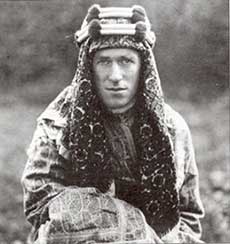
The dramatic downturn in cargo volumes and passenger numbers was compounded by political and civil unrest in India and China and the ‘menace of state-aided competition’, which brought about the demise of P&O’s Branch Line to Australia.
A new ‘tourist class’ was created to appeal to a generation of cash-conscious passengers, and also a growing number of cruisers, which coincided with the introduction of a new class of ‘white’ liners built for the Australian mail service.
Strathnaver, the first of the ‘Strath’ class, was launched in 1931 and took her name from the hereditary title adopted by Inchcape, when he was knighted in 1911. The Straths were to be Inchcape’s last legacy. He died in 1932 leaving his son-in-law, Alexander Shaw, later Lord Craigmyle, to succeed him as Chairman of P&O.
By 1937 Britain had a new monarch, King George VI, and the celebrations coincided with the Company’s own moment in history. P&O had been in business for a century. But, before long a new gloom descended. On 3rd September 1939, the Prime Minister, Neville Chamberlain, made his now historic broadcast to the nation.
Britain was at war with Germany, again.
Mahatma Gandhi departed Bombay for Marseilles on board Rajputana on 29th August 1931. From Marseilles he continued his journey on the overland express arriving in London for the 'Round Table Conference'.
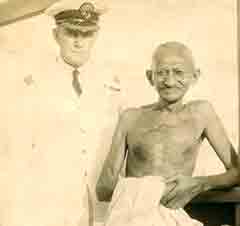
Sir William Currie, who had succeeded Lord Craigmyle in 1938, found himself at the helm of a Company at war and, as Director of the Liner Division at the Ministry of Transport, steering a wider merchant fleet through treacherous waters.
As a whole the merchant navy suffered heavily. Nearly 3,000 ships and 30,000 lives were lost - twice the number killed in the First World War.
By the time peace was declared, the P&O fleet had been reduced to half of its original might and the remaining ships required extensive reconditioning. The first services to Australia and China resumed in 1947, but it wasn’t until the end of the decade that the Company was back to anything approaching ‘business as usual’.
At the same time there was the added complication of a new order emerging in the Empire of old. In 1947 India gained independence and the British Empire, which had sustained both Company and country for so long, began to falter…
Himalaya was the first P&O liner that could turn sea water into drinking water. The ship was fitted with a ‘Weir evaporating plant’ for distilling water.
Diversifying into the tanker trade was a sign of changing times for P&O. There were new threats to the Company’s traditional trades. The Empire was disintegrating and competition came not just in the form of newly independent nations, but also from the growth in travel and mail by air. To cap it all, a year-long crisis in Suez closed the Canal with disastrous effects on shipping.
But there were opportunities too. Besides cargo, and a new venture into cold storage, P&O had re-entered the emigration trade carrying the ‘ten pound poms’ in their thousands to Australia. When cruising resumed in 1950, numbers of tourist class passengers soared to a new height. By 1955 there was a need for two new passenger liners. Together P&O and Orient announced the construction of Canberra and Oriana - superliners of a speed and scale not seen before on the Australian run.
In the wider group, BI celebrated their centenary in 1956 and acquired the business of their forefathers, Mackinnon Mackenzie, a year later. With 54,000 employees worldwide, and a network of shipping interests, P&O was well placed to meet the challenges of a changing commonwealth in a new Elizabethan era.
There were 37 babies born on board Ranchi in 1950.
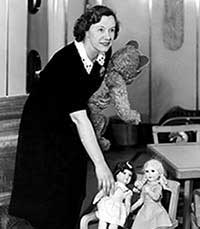
New types of ships rolled off the stocks in the UK, Germany and Japan. These were operated and managed by consortia; Associated Bulk Carriers, North Sea Ferries, Normandy Ferries, Panocean and Overseas Containers Ltd (OCL).
In 1964 P&O Offshore Services was set up to supply the oil and gas rigs of the North Sea from a fleet of small vessels. Beyond the sea, the Company bought a road haulage company in Australia and Ferrymasters in the UK.
In 1960 P&O acquired the remaining share of the Orient Line and the latest liners, Oriana and Canberra, operated under the new name P&O-Orient Line. Emigrant numbers peaked at 80,000 in 1969, creating a bounty on the UK/Australia run which belied the general decline in liner voyages. The Company’s services from UK to New Zealand and the Far East closed in the same year.
You could go to school at sea. In 1961 Dunera, a former troopship, became the first of the BI ships to pioneer educational cruising.
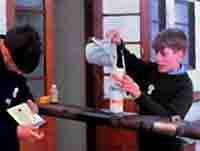
The restructure was instigated by Ford Geddes, Sir Donald Anderson’s second cousin and his successor, as P&O’s Chairman, in 1971. Geddes had another idea, which was to prove rather more divisive…
The property industry was booming and, backed by others on the board, Geddes proposed the acquisition of the property and construction company Bovis. The deal nearly came to pass but for one director, Lord Inchcape, who was vehemently opposed to it. Dissension reverberated far beyond the boardroom walls of Leadenhall Street. The details of the deal divided investors. But Inchcape stood firm by his assertion that Bovis was overvalued and that it stood to gain at the expense of P&O. As a counter offer, Inchcape launched a bid for P&O itself.
Equally opposed to the Bovis deal, Sir Donald Anderson, the former chairman, was moved to intervene and proffer a third way: P&O could continue as before but with Inchcape in charge. Individual shareholders approved and, by the close of ballot day on 20th November 1972, Geddes and half the board were out and Inchcape was in, occupying the role of Chairman that had been his grandfather’s over 50 years before.
The battle had lasted 100 days. It had been both bloody and public, but P&O was worth the fight. In a final twist of events, Inchcape presided over the acquisition of Bovis two years later, for a fifth of the original offer price...
P&O owned and operated a mini-submersible ship, Aquarius 1 in 1974. The manned submarine was used for offshore oil and cable work.
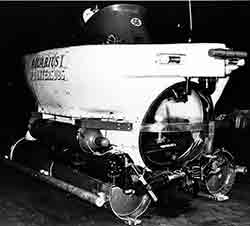
With one war fought, and won, there was another conflict to settle much closer to home. On 2nd June 1983 the shipping and property conglomerate, Trafalgar House, launched a hostile bid for P&O. The chairman, Inchcape, then on the point of retiring, stayed to tackle the crisis. The bid was referred to the monopolies and mergers commission and by the time the go-ahead was given, P&O had a new, younger chairman in Jeffrey Sterling. The new guard had the backing of the shareholders and the City, prompting Trafalgar House, in the face of certain defeat, to withdraw their bid.
Sterling further bolstered P&O in a merger with his own property and service company, Sterling Guarantee Trust. Within a year P&O was a larger, more diversified group with capital in excess of £1000 million.
P&O went on to acquire full control of OCL in 1986 and the European Ferries Group in 1987. It was a triumphant start to P&O’s 150th anniversary year but within days of taking over European Ferries, one of their fleet, the Herald of Free Enterprise, capsized on departure from Zeebrugge, with the loss of 193 lives.
In the face of such an appalling tragedy, P&O drew strength from its past and determined to look forward.
P&O extended its operations to every continent, including Antarctica, in 1988.

Strategic joint ventures provided the necessary structure to protect P&O Ferries from the new threat of the channel tunnel and P&O Containers from falling rates and overcapacity.
In a shift of focus towards those areas of the Company affording the highest growth and returns, a string of assets were sold including; P&O Oilfields, P&O Tankships and the exhibition centres Earls Court & Olympia. In 1999 the much expanded Bovis Group, which had been part of P&O for 25 years, was sold following the successful flotation of Bovis Homes a year before.
A large capital investment in cruising facilitated the building of six new cruise ships in as many years. P&O Ferries opened a new route from Portsmouth to Bilbao and added several new ferries to their growing fleet and operations.
On the other side of the world, P&O Australia was quietly expanding its port operations and building a portfolio of international container terminals, which would rapidly become the jewel in the Company’s crown.
P&O had to seek permission from Her Majesty The Queen to alter the Company's royal charter in July 1992.
Several interests were sold; P&O Cold Logistics, P&O Trans European and P&O’s remaining share in container shipping line P&O Nedlloyd. Core businesses were revitalised. P&O Ferries introduced two new 60,000 ton cruise ferries Pride of Rotterdam and Pride of Hull and acquired Stena Line's share in the Dover/Calais service in 2002.
There was a sea change at the top with the departure first of Sir Bruce MacPhail as CEO and then Lord Sterling, who stepped down as Chairman in 2005 after 30 years. The duo, who had steered the Company's course for the best part of three decades, were succeeded by Robert Woods CBE and Sir John Parker respectively.
P&O’s future focus pointed to ports where capital raised was reinvested in marine terminals stretching from Buenos Aires to Vostochny and far beyond. It was this enviable geographical spread that attracted interest from DP World. P&O was the perfect fit and after a bidding war with PSA, P&O shareholders voted overwhelmingly to approve the DP World bid on 13th February 2006.
A new era, in a new millennia, had begun.
A team of 25 ecologists have re-housed over 50,000 animals from across the London Gateway site including water voles, Great Crested newts, adders, grass snakes and lizards. Find out more here

The history of P&O is not without the peaks and troughs and crises that befall any commercial endeavour. Even the Company’s longest serving chairman, Sir Thomas Sutherland, pondered the unanswerable, in 1910, when he posed the question of how long the P&O story would continue:
'Well, gentlemen, long may this continue. How long?
Let us say for another seventy-five years – or at all events as much longer as possible.'
185 years later, we’re still counting…
The cranes delivered to London Gateway in March 2013 were the biggest cranes ever seen in Britain and bigger than the London Eye. See how big they really are here.
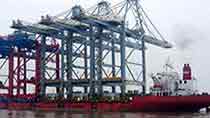
Share
Facebook Twitter Google+